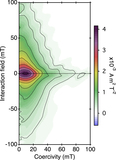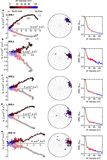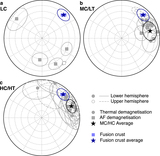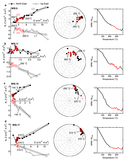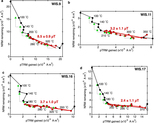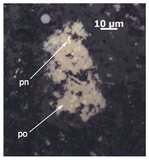Image Details
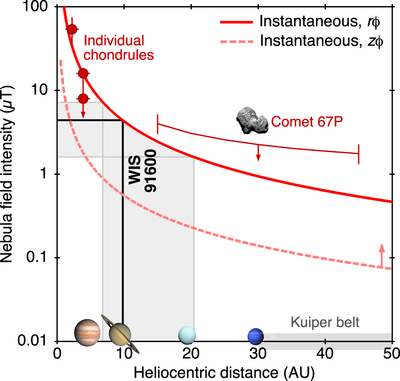
Caption: Figure 12.
Calculated minimum intensity profiles of the instantaneous component of the nebula field for vertical-azimuthal (zϕ) and radial-azimuthal (rϕ) coupling of the Maxwell stress tensor required to generate a steady-state solar accretion rate of 10−8 MSun Myr−1 (Bai & Goodman 2009). The paleointensities recovered from individual chondrules extracted from an LL chondrite (Fu et al. 2014), the upper limits on the possible paleointensities experienced by individual chondrules extracted from two CR chondrites (Fu et al. 2020), and the paleointensity limit recovered from comet 67P/Churyumov–Gerasimenko during the Rosetta mission (Biersteker et al. 2019) are plotted at estimates of their formation distances (Desch et al. 2018). The calculated minimum intensity estimate for rϕ coupling is consistent with the measured paleointensities of the individual chondrules and the limit recovered from 67P/Churyumov–Gerasimenko. As such, for the purposes of this study, we assume that this minimum intensity profile represents the paleointensities that would be recorded by quickly cooled meteorites during the later stages of the solar nebula (matching the possible thermal history of WIS 91600). Because the calculated profiles are minimum intensity estimates, the calculated profile for zϕ coupling is still compatible with the measured paleointensities from the individual chondrules. However, the recovered paleointensities argue that, if this was the form of the coupling of the Maxwell stress tensor, this field must have been approximately an order of magnitude stronger than its minimum possible value. If this were the case, the profile for zϕ coupling would produce a very similar estimate of the formation distance of the WIS 91600 parent body to that predicted by our adopted rϕ profile. The adopted intensity profile reaches 4.4 μT at 9.8 au (black lines), indicating that WIS 91600 was impact heated in the far reaches of the solar system. The ranges of uncertainty in the paleointensity (accounting for the range in our values recovered from individual subsamples) and formation distances are shown by the gray bars. The present-day heliocentric distances of the giant planets and Kuiper Belt are included.
Copyright and Terms & Conditions
© 2020. The American Astronomical Society. All rights reserved.


